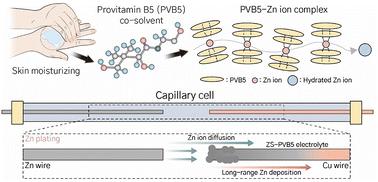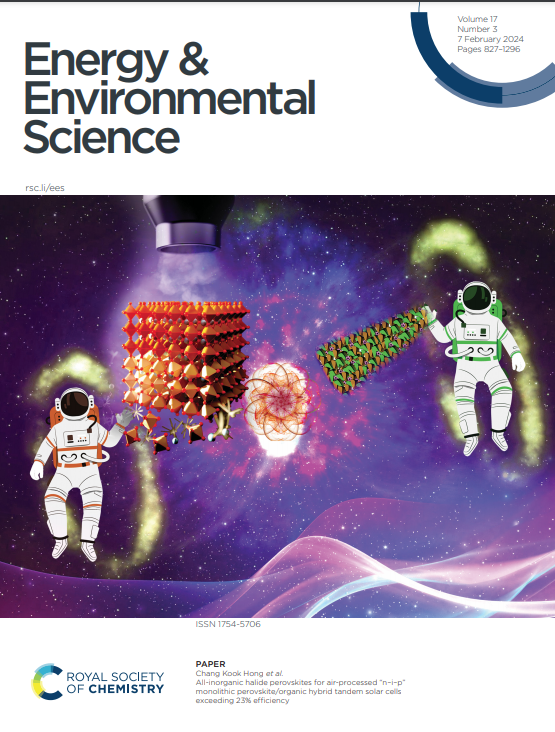可持续水锌离子电池中与几何无关的均匀锌沉积
IF 30.8
1区 材料科学
Q1 CHEMISTRY, MULTIDISCIPLINARY
引用次数: 0
摘要
为了解决诸如枝晶生长、析氢和腐蚀等问题,这些问题降低了水锌离子电池的可逆性和均匀锌沉积,大量的研究集中在开发无机助溶剂系统上。然而,许多正在研究的共溶剂都是剧毒的。在这里,为了克服这些限制,我们使用了维生素原B5,一种环保和生物相容性的助溶剂,通常用于皮肤保湿剂。通过异核多键相关(HMBC)证实了电解质中独特的维生素B5 -锌离子复合物的形成,表明维生素B5原分子与锌离子之间存在强相互作用。该复合物显著增强了锌离子的扩散,使锌在毛细血管细胞中均匀沉积至3.2 cm,没有枝晶生长和析氢。结果表明,维生素原B5共溶剂在1 mAh cm−2条件下,在1 mA cm−2条件下可保持3500小时的循环稳定性,即使在35%的放电深度条件下,也能保持600小时的稳定运行。此外,在袋状电池条件下,满电池的循环保留率为90%,库仑效率为99.75%。该研究为高可逆可持续水离子电池的共溶剂工程提供了新的平台。本文章由计算机程序翻译,如有差异,请以英文原文为准。

Geometry-independent uniform zinc deposition in sustainable aqueous zinc-ion batteries
To address challenges such as dendrite growth, hydrogen evolution, and corrosion that degrade the reversibility and uniform zinc deposition in aqueous zinc-ion batteries, extensive research has focused on developing inorganic co-solvent systems. However, many of the co-solvents under investigation are highly toxic. Herein, to overcome these limitations, we employed provitamin B5, an eco-friendly and biocompatible co-solvent commonly used in skin moisturizers. The formation of a unique provitamin B5–zinc ion complex in the electrolyte was confirmed through heteronuclear multiple bond correlation (HMBC), indicating strong interactions between provitamin B5 molecules and zinc ions. This complex significantly enhanced zinc ion diffusion, enabling uniform zinc deposition up to 3.2 cm in a capillary cell without dendritic growth and hydrogen evolution. As a result, these effects of provitamin B5 co-solvent exhibited outstanding cycling stability for 3500 hours at 1 mA cm−2 under 1 mAh cm−2 conditions, and even under a harsh 35% depth-of-discharge condition, it maintained stable operation for 600 hours. Moreover, the full cell under pouch cell conditions revealed a remarkable cycle retention of 90% with a Coulombic efficiency of 99.75% over 1000 cycles. This study offers a new platform to co-solvent engineering for highly reversible and sustainable aqueous-ion batteries.
求助全文
通过发布文献求助,成功后即可免费获取论文全文。
去求助
来源期刊

Energy & Environmental Science
化学-工程:化工
CiteScore
50.50
自引率
2.20%
发文量
349
审稿时长
2.2 months
期刊介绍:
Energy & Environmental Science, a peer-reviewed scientific journal, publishes original research and review articles covering interdisciplinary topics in the (bio)chemical and (bio)physical sciences, as well as chemical engineering disciplines. Published monthly by the Royal Society of Chemistry (RSC), a not-for-profit publisher, Energy & Environmental Science is recognized as a leading journal. It boasts an impressive impact factor of 8.500 as of 2009, ranking 8th among 140 journals in the category "Chemistry, Multidisciplinary," second among 71 journals in "Energy & Fuels," second among 128 journals in "Engineering, Chemical," and first among 181 scientific journals in "Environmental Sciences."
Energy & Environmental Science publishes various types of articles, including Research Papers (original scientific work), Review Articles, Perspectives, and Minireviews (feature review-type articles of broad interest), Communications (original scientific work of an urgent nature), Opinions (personal, often speculative viewpoints or hypotheses on current topics), and Analysis Articles (in-depth examination of energy-related issues).
 求助内容:
求助内容: 应助结果提醒方式:
应助结果提醒方式:


